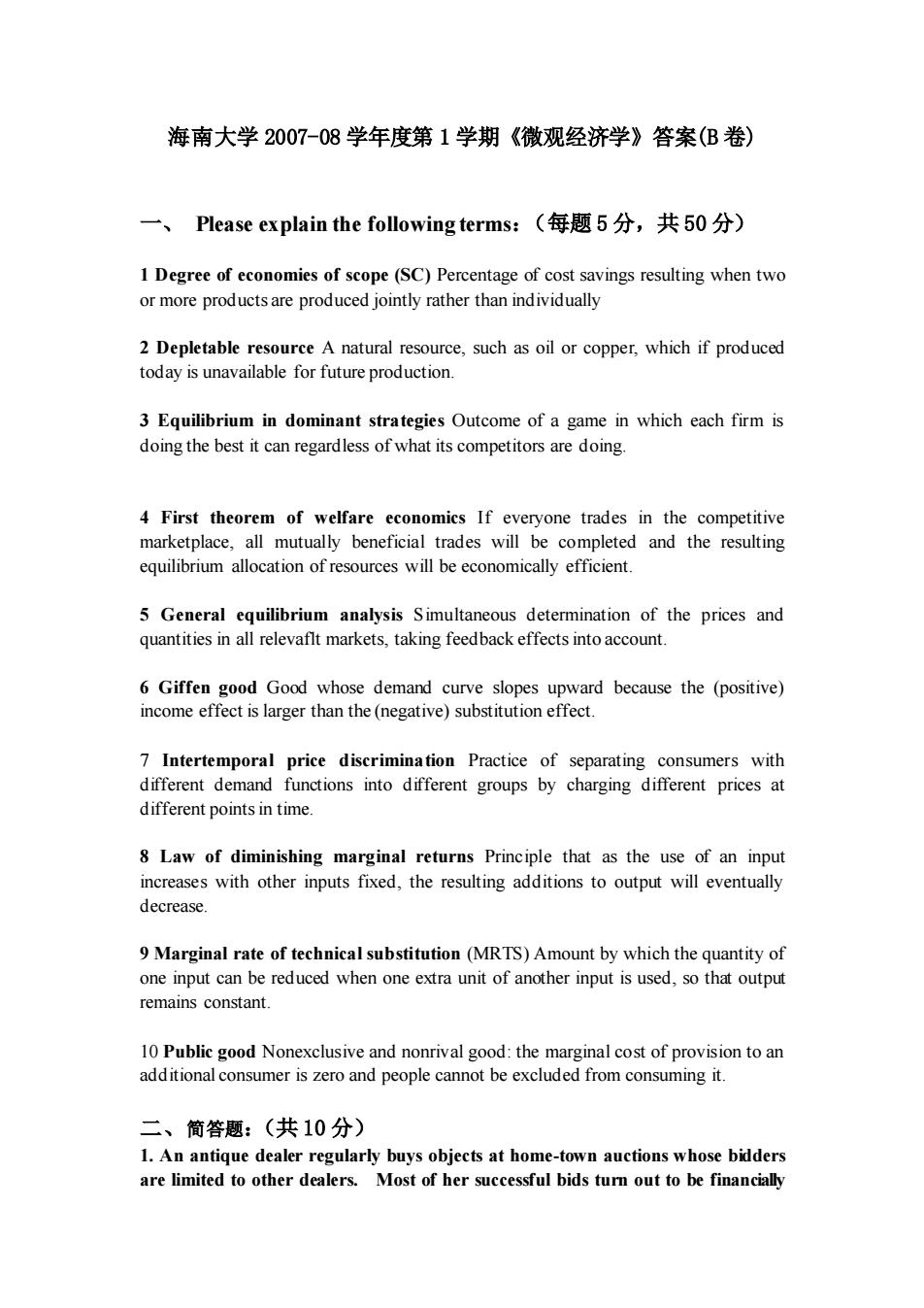正在加载图片...

海南大学2007-08学年度第1学期《微观经济学》答案(B卷) 一、Please explain the following terms:(每题5分,共50分) 1 Degree of economies of scope (SC)Percentage of cost savings resulting when two or more products are produced jointly rather than individually 2 Depletable resource A natural resource,such as oil or copper,which if produced today is unavailable for future production 3 Equilibrium in dominant strategies Outcome of a game in which each firm is doing the best it can regardless of what its competitors are doing. 4 First theorem of welfare economics If everyone trades in the competitive marketplace,all mutually beneficial trades will be completed and the resulting equilibrium allocation of resources will be economically efficient. 5 General ea quilibri m analysis Simultand ous determination of the prices and quantities in all relevaflt markets,taking feedback effects into account 6 Giffen good Good whose demand curve slopes upward because the (positive) income effect is larger than the(negative)substitution effect. 7 Intertemporal price discrimination Practice of separating consumers with different demand functions into different groups by charging different prices at different points in time. 8 Law of diminishing marginal returns Principle that as the use of an input with other inputs fied.the resulting addtons to output will eventually 9 Marginal rate of technical substitution (MRTS)Amount by which the quantity of one input can be reduced when one extra unit of another input is used,so that output remains constant. 10 Publie good Nonexclusive and nonrival good:the marginal cost of provision to an additional consumer is zero and people cannot be excluded from consuming it. 二、简答题:(共10分) 1.An antique dealer regularly buys objects at home-town auctions whose bidders are limited to other dealers.Most of her successful bids tu out to be financially海南大学 2007-08 学年度第 1 学期《微观经济学》答案(B 卷) 一、 Please explain the following terms:(每题 5 分,共 50 分) 1 Degree of economies of scope (SC) Percentage of cost savings resulting when two or more products are produced jointly rather than individually 2 Depletable resource A natural resource, such as oil or copper, which if produced today is unavailable for future production. 3 Equilibrium in dominant strategies Outcome of a game in which each firm is doing the best it can regardless of what its competitors are doing. 4 First theorem of welfare economics If everyone trades in the competitive marketplace, all mutually beneficial trades will be completed and the resulting equilibrium allocation of resources will be economically efficient. 5 General equilibrium analysis Simultaneous determination of the prices and quantities in all relevaflt markets, taking feedback effects into account. 6 Giffen good Good whose demand curve slopes upward because the (positive) income effect is larger than the (negative) substitution effect. 7 Intertemporal price discrimination Practice of separating consumers with different demand functions into different groups by charging different prices at different points in time. 8 Law of diminishing marginal returns Principle that as the use of an input increases with other inputs fixed, the resulting additions to output will eventually decrease. 9 Marginal rate of technical substitution (MRTS) Amount by which the quantity of one input can be reduced when one extra unit of another input is used, so that output remains constant. 10 Public good Nonexclusive and nonrival good: the marginal cost of provision to an additional consumer is zero and people cannot be excluded from consuming it. 二、简答题:(共 10 分) 1. An antique dealer regularly buys objects at home-town auctions whose bidders are limited to other dealers. Most of her successful bids turn out to be financially